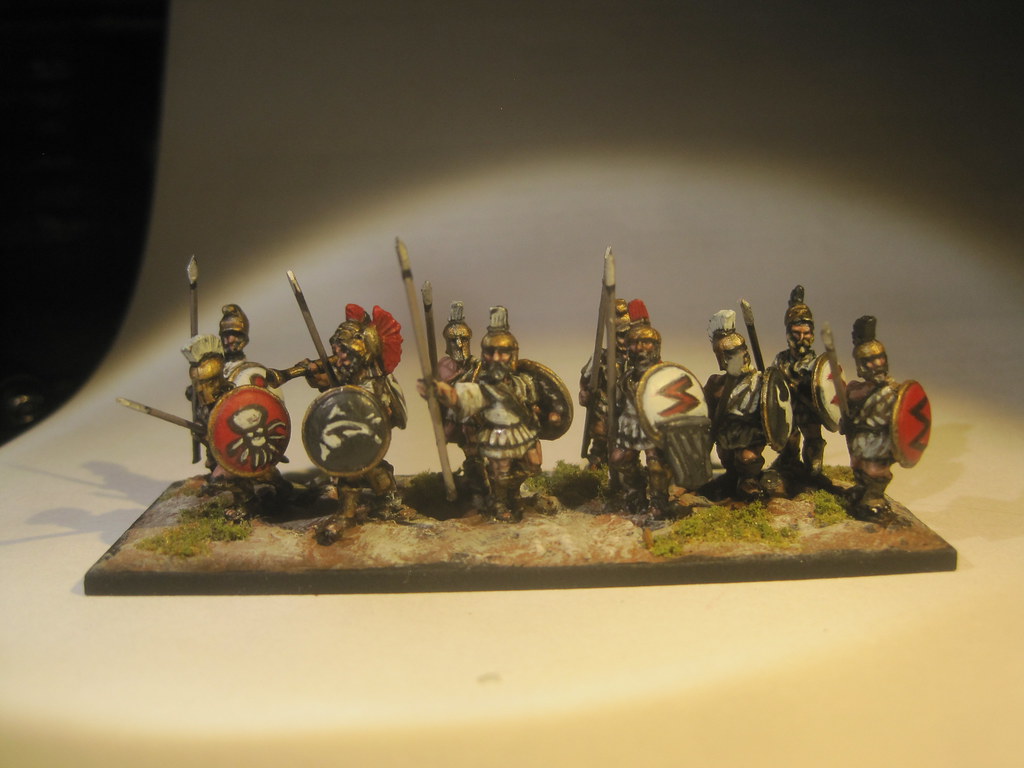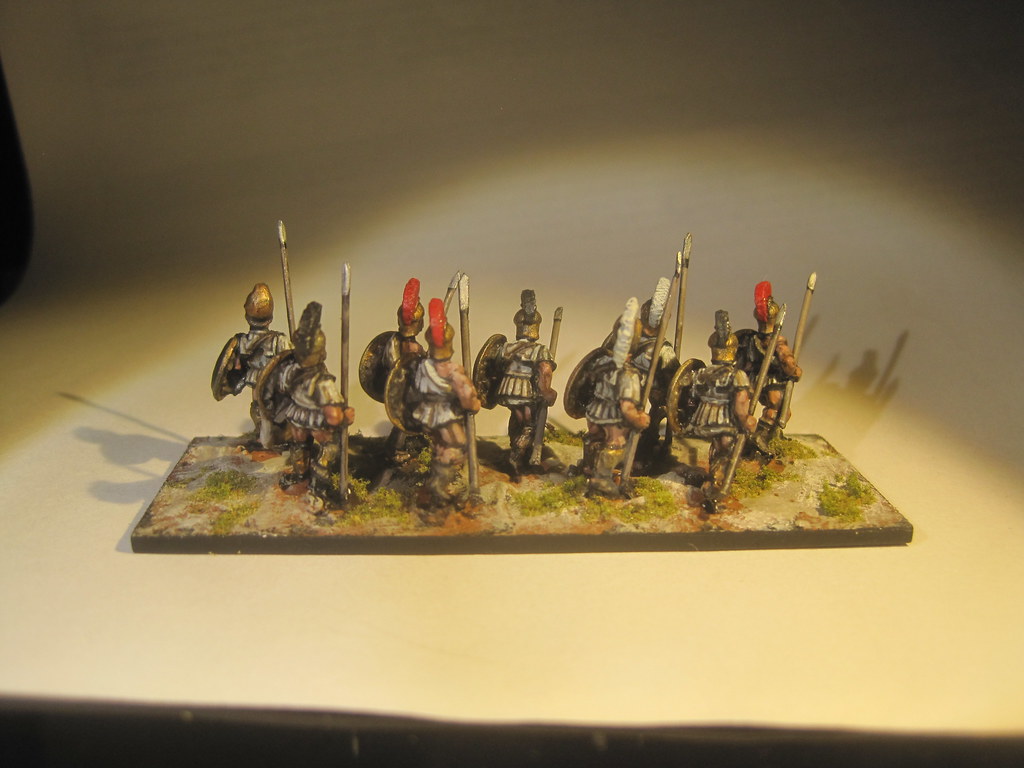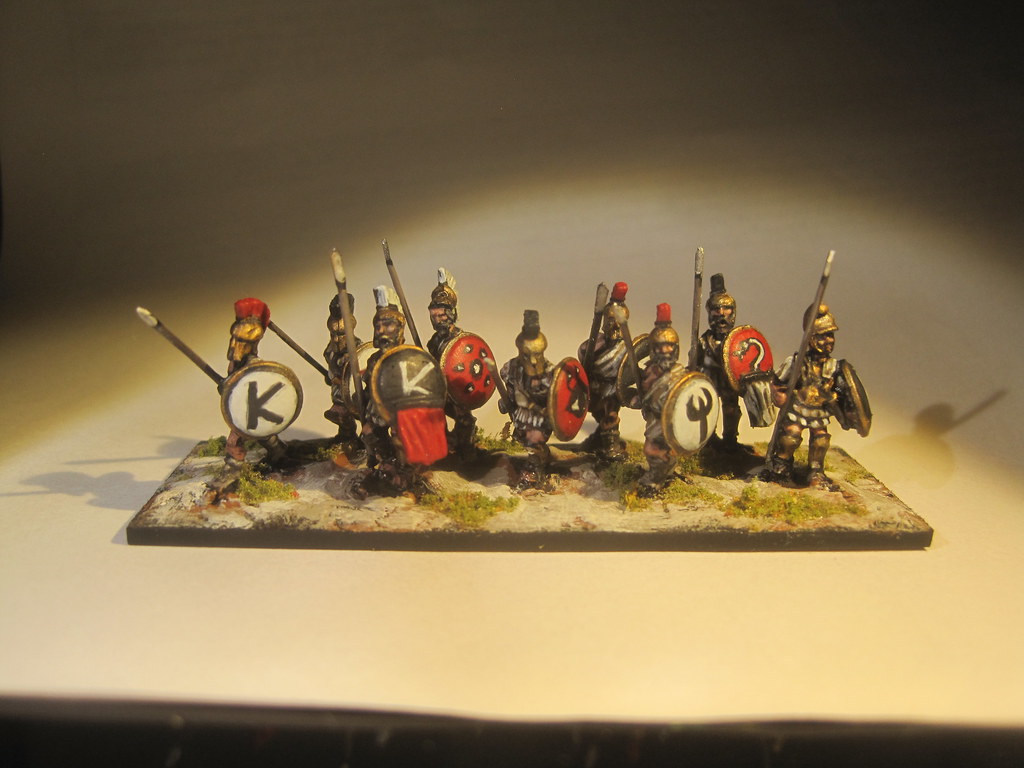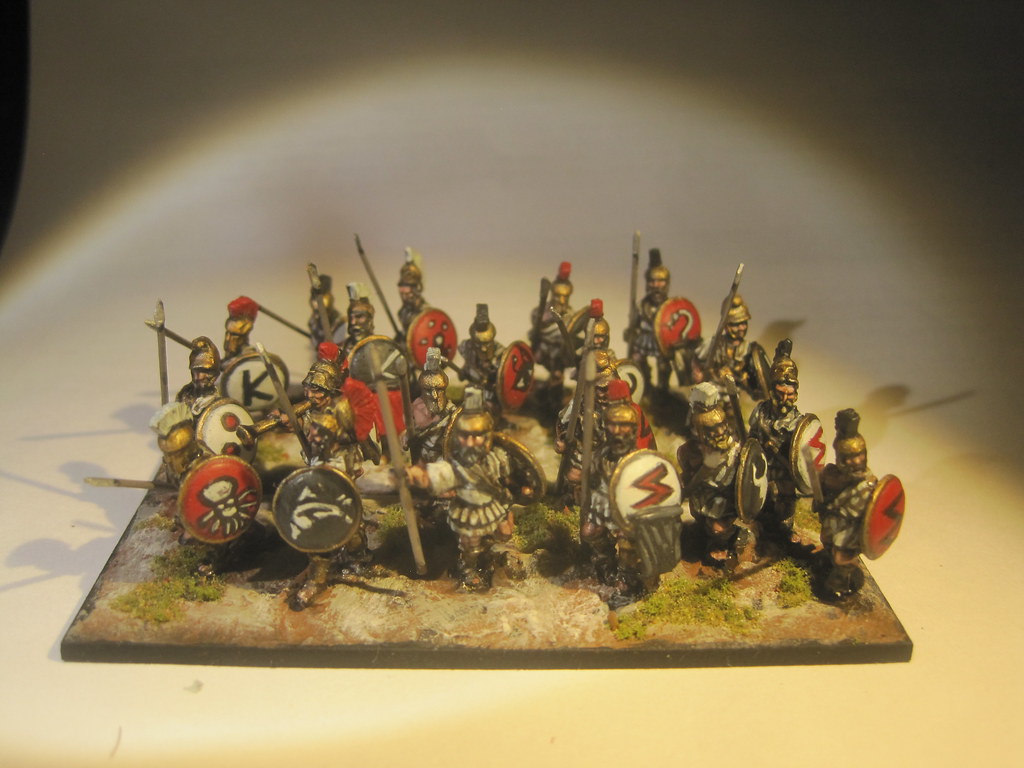Finished up some more bases for the Spartans, in this case, allied hoplites.
 |
| Front rank hoplites. Leader is converted from a guy holding a sword. |
 |
| Packed a couple extra figs on the front. These guys are less disciplined than Spartans. |
Impetus Unit Type: FP
Base Size: 8cm x 3cm
Manufacturer: OG15mm
In contrast to the rest of the Spartan army, these guys are Old Glory, part of the big batch of OG15 figs I picked up a while back. I've painted up some of these before, as Lykian hoplites in my Antigonid list. In contrast to that first batch, however, with this gang I stuck with a more restrained palette, and limited myself to the same colour scheme as on the Spartans themselves. Shields are a mix of city and personal icons, and I repeated a few from the Lykians, including the octopus, because it's fun. With this lot done, all that's left for the Spartans are skirmishers and light troops - the beginning of the end (or possibly vice versa) is in sight!
 |
| Rear rank. |
 |
| Rear rank rear. Which seems redundant, somehow. |
These guys will serve as allied hoplites in my Spartan list. In Impetus, and to be honest most rulesets, "pure" Spartan lists are actually pretty rare, in that most have mandatory non-Spartan hoplites (not just periokoi or armed helots, but non-lacedemonian hoplites). This does, as has been pointed out to me (see Ross' comments on my Spartan cavalry post), reflect the historical record, but raises the question of why have a dedicated Spartan list at all?
Sword and Spear handles this with a generic "later hoplite" list, in which is included the option to take "Spartan" hoplites as a core choice, but the Spartan hoplite profile is identical to that of "elite hoplites", which are non-core. So, Spartan armies are basically just hoplite armies with elite hoplites as the core of the force, which makes sense at one level, but also has me chewing over a larger set of ideas about rules and lists.
 |
| All together. |
 |
| Hopefully an angle the opponent never sees. |
Like a fair number of people out there, I came to historical gaming via fantasy / sci-fi games, where predetermined lists intended to allow for balanced pick-up games were the norm. I've found, over the years, however, that I am increasingly drawn to rulesets with more flexibility in army selection, or which are based on scenario-based play, even to the extreme of the Warlord / Black Book rulesets, where you can pretty much do what you want. What seems to be really grabbing me these days are "what if" scenarios for historicals, things that might have plausibly or possible happened, even if we don't know that the did. Given how most historical "army lists" are based on a fairly narrow interpretation of the few things we know about ancient battles, they can become a little restrictive for this purpose.
A rule system that offers some guidelines on what might have been available, but leaves room for players to decide what to take (and what factors to consider when deciding what to take) is probably the sweet sport for me right now. There is, of course, nothing stopping me from doing this with pretty much any set of rules out there, but I've definitely noticed that I'm becoming aware of what "stock" rulesets allow and discourage. Don't know if that means I'm maturing as a gamer, or just becoming an old crank ;)
FMB
Old crank with a tentacle fixation, obvs.
ReplyDeleteThey taste good too . . .
DeleteSounds like a waste of good mushroom gravy though.
DeleteThe Hoplites and esp the shields look great.
ReplyDeleteFor decades now I have preferred to start by studying historical the orders of battles, preferably first and ones as well as modern reconstructions) to get a feel of what was possible (despite how vague some of them are, especially for small affairs). However, unless the rules being used are geared to an appropriate scale for the battle you are studying, translating army lists from historical battles can soon become problematic and "artistic license" has to be employed. This gets exaggerated if the designer wants to hype the 'flavour' of an army, or its competition value.
Luckily, its "just' a game.
Part of it, I think, is I've now seen enough rule sets to get a sense of the different ways people handle certain issues / demands / concerns. Just an evolving sense of what options are out there, and what I like.
DeleteSplendid!
ReplyDeleteLovely hoplites! Very nice shields,I like to build armies based on a particular historical point if possible, and then get to mess with them later!
ReplyDeleteBest Iain
Yeah, that seems a good balance; historically playable, but with options.
DeleteAbsolutly superb, presentation, painting and basing...
ReplyDeleteCheers, thanks, Phil!
DeleteNice looking unit. I also like more historical scenarios than straight point matches , with the army lists to fit the scenario. Points are a useful guideline to balance but not a must. I think it’s maturing as a gamer. 😀
ReplyDeleteHad to happen sooner or later ;)
DeleteI am firmly an historical man, myself. What others enjoy in the privacy of their home is of no concern to me...
ReplyDeleteThe Old Glory Greeks are really nice figures brought to life by your brushwork. Shields are superb.
Cheers Jonathan!
DeleteFantastic painting fmb, I thought they were 28mm at first!
ReplyDeleteThanks, Cyrus, appreciate that!
DeleteThey look very nice!
ReplyDeleteChristopher
Thanks, Christopher!
DeleteThis comment has been removed by a blog administrator.
ReplyDelete